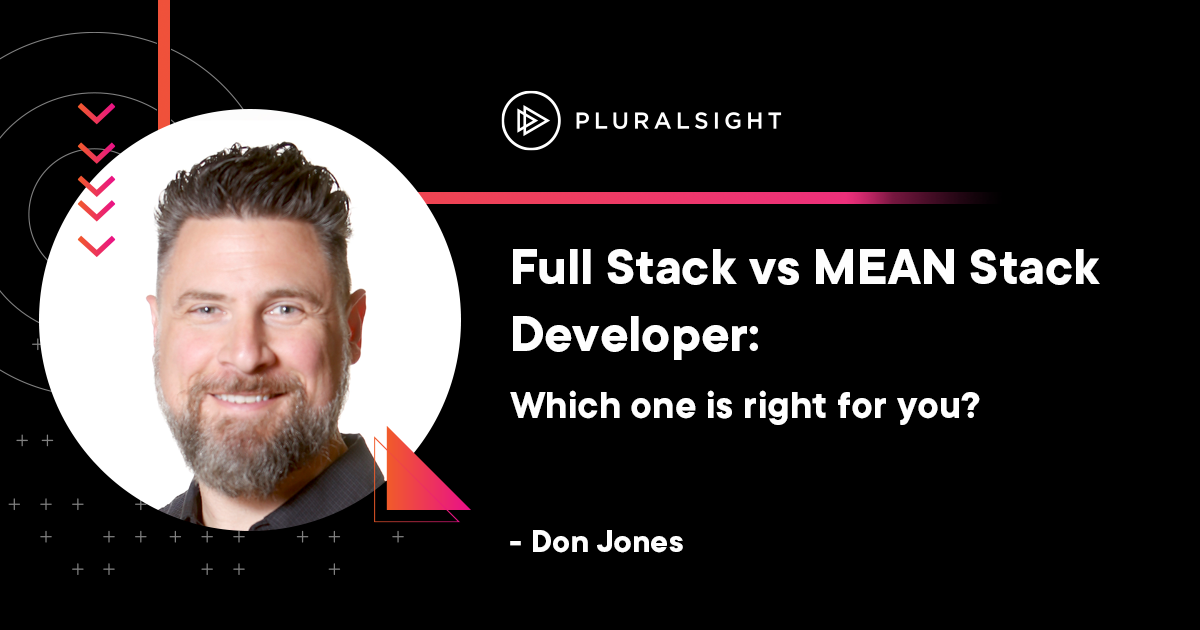Author: Don Jones
Part two of a four part series on MEAN Stack. Missed part one? Get the 101 on MEAN Stack development
To determine whether MEAN or Full Stack development is right for you, let’s first break down the similarities and differences between the two frameworks. MEAN is a JavaScript-based framework for developing cloud-hosted web applications. The acronym MEAN stands for each technology comprising a layer in the stack:
- MongoDB: a NoSQL document database
- Express (.js): a Node.js framework for building web applications
- Angular (.js): a structural JavaScript framework
- Node(.js): a JavaScript web server
Over the last decade, MEAN has grown in popularity due to the flexibility and accessibility of its technology layers. The framework is most commonly used to build dynamic web applications and websites.
The term “full-stack” is used to describe the ability to develop both the front-end and back-end. Unlike MEAN, full-stack doesn’t describe specific technologies. Instead, it’s a capability and often refers to developers who can work on the front and back-end.
Front-end development refers to the client-side of things. It includes the visual elements that a user will interact with on an app or website. Front-end developers take care of everything needed to make your app or site look and feel seamless. Common languages for front-end development include HTML, CSS, and JavaScript.
Back-end development describes everything on the server-side. These are the nitty-gritty elements that most users won’t even consider when using your app or site. Back-end developers write the code to make sure the database and application can communicate. They handle the server-side logic and application. Common languages for back-end development include Java, PHP, and Python.
Full-stack developers have the skills to develop both the front and back-end and mastery of the languages required for both sides. MEAN developers must be proficient in JavaScript technologies, including MongoDB, Express.js, Angular, and NodeJS
We should note that MEAN stack developers often work on the front and back-end. This is because they use a single programming language (JavaScript) to develop both the client and server-side of an app or website. You won’t typically hear of a MEAN stack developer referred to as a full-stack developer, however.
## Career Differences for MEAN and Full Stack Developers
What can you expect as a MEAN or full-stack developer? While both roles work on the front- and back-end, there are some differences in responsibilities, requirements, and salary expectations.
Typical MEAN Stack Developer Responsibilities
MEAN Stack Developers use four technologies (MongoDB, ExpressJS, AngularJS, NodeJS) to develop the front and back-end of an application or website. They often perform the following tasks:
- Develop dynamic, scalable web applications
- Define code architecture decisions
- Collaborate with analysts, designers, data implementation specialists, researchers, and information architects
- Identify and address technical issues that may arise during a project
- Design and maintain databases (relational and non-relational)
- Deploy applications on the cloud
- Debug any hosting-related issues
Typical MEAN Stack Developer Requirements
MEAN stack developers must have a strong understanding of JavaScript. It is also recommended they have deep experience with each layer of the MEAN stack. It’s beneficial for developers to be familiar with the MEVN stack, which replaces Angular.js for Vue.js, a front-end JavaScript framework. Likewise, it’s helpful for them to understand MERN, where Angular.js is swapped out with React.js. React.js is a front-end JavaScript library.
The Average MEAN Stack Developer Salary
What can MEAN stack developers expect as far as pay? According to Glassdoor, the national average salary for MEAN Stack Developers is $89,817 per year in the United States. The salary distribution ranges from $66,000 to $122,000 annually.
Typical Full Stack Developer Responsibilities
Full-stack developers build the client and server-side elements of a website or application. They are responsible for developing the front-end architecture of a project and translating mock-ups and wireframes into code. Full-stack developers will typically be asked to do the following on a project:
- Develop RESTful services and APIs
- Design user interactions
- Develop databases, applications, and servers
- Consider non-functional requirements such as security, usability, scalability, reliability, etc.
- Optimize for mobile devices
Typical Full Stack Developer Requirements
Full-stack developers should be proficient with front-end languages (e.g., HTML, CSS, and JavaScript), JavaScript frameworks, server-side languages (e.g., Python, PHP, .Net), and database technologies (MySQL, Oracle, and MongoDB). Because this role works on the client and server-side, it’s beneficial to possess strong organizational and project management skills.
The Average Full Stack Developer Salary
Glassdoor estimates the national average salary for full-stack developers in the United States to be $99,274. The salary range is $62,000 to $159,000 annually.
## The MEAN Stack Advantage for Businesses
There’s no doubt companies are hiring MEAN stack developers. LinkedIn currently has over 87,000 jobs posted for the role in the United States. So, what makes the role so popular? Let’s take a look at some examples of the MEAN stack’s advantages over other frameworks.
First, it’s completely based on JavaScript. That means developers can build an app from start to finish with one programming language. JavaScript is completely free, which is a definite plus.
You can also seamlessly switch between the server and client-side without having to use a third-party standalone server. Instead, the developer can deploy apps directly to the server through Node.js.
The uses of the MEAN stack vary, but the framework is most commonly used to create robust, scalable, and dynamic cloud-based applications. Its code is also isomorphic, meaning code written in one framework can be transferred to another. So, any apps built using MEAN can function on multiple platforms without having to alter the base code. This capability saves businesses time and money while allowing them to expand to multiple platforms.
Studying to become a MEAN stack developer? Don’t miss the next article in the series on essential MEAN stack courses.
